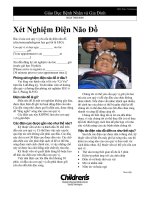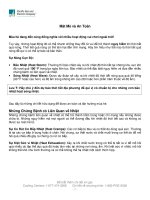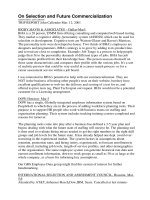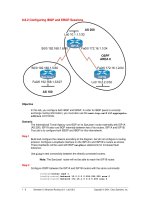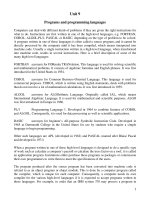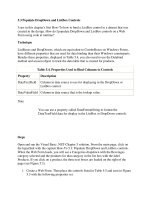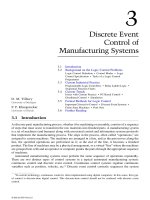Tài liệu Bronchial Anthracosis and Pulmonary Tuberculosis pdf
Bạn đang xem bản rút gọn của tài liệu. Xem và tải ngay bản đầy đủ của tài liệu tại đây (285.98 KB, 5 trang )
Tanaffos (2010) 9(2), 21-25
©2010 NRITLD, National Research Institute of Tuberculosis and Lung Disease, Iran
Bronchial Anthracosis and Pulmonary Tuberculosis
Mitra Samareh Fekri
1
, Mohammad Reza Lashkarizadeh
2
, Amir Hossein Kardoost
1
, Mostafa Shokoohi
3
1
Department of Pulmonary Medicine,
2
Department of Surgery,
3
Kerman Physiology Research Center, Kerman University of Medical
Sciences, KERMAN-IRAN.
ABSTRACT
Background: Bronchial anthracosis is defined as appearance of multiple dark anthracotic pigmentations on large airway
mucosa with or without airway narrowing or obliteration. Since there has been vague and controversy regarding the
relationship between bronchial anthracosis and pulmonary tuberculosis, we conducted this study to shed light on this matter.
Materials and Methods: In this cross-sectional study, data was obtained from reviewing the files of 1,594 patients who
underwent bronchoscopy in Afzalipour Hospital during 2003 to 2007. Those with dark pigmentation on their airways mucosa
were considered as having bronchial anthracosis. During bronchoscopy, samples were collected from the airways in the form
of bronchoalveolar lavage and then the smear and culture of these samples were examined for acid fast bacilli. Patients with
both positive culture and smear and those with positive culture alone for acid fast bacilli were considered as having
pulmonary tuberculosis.
Results: Of 1,594 cases studied in this research, 333 (20.8%) had bronchial anthracosis, out of which 158 (55.5%) were
women. Risk of bronchial anthracosis was 0.4 times less in men (CI 95%=0.32-0.52) (p<0.001). In other words, bronchial
anthracosis had a significantly less prevalence among men. Also, risk of tuberculosis in people with bronchial anthracosis
was 2.6 times more than that of healthy people (CI 95%= 1.48-4.75) (p<0.001).
Conclusion: This research revealed a significant correlation between bronchial anthracosis and pulmonary tuberculosis.
Therefore, performing necessary tests and follow-ups for pulmonary tuberculosis is necessary in cases that undergo
bronchoscopy for any reason and those with bronchial anthracosis. (Tanaffos 2010; 9(2): 21-25)
Key words: Bronchial anthracosis, Pulmonary tuberculosis, Bronchoscopy
INTRODUCTION
Anthracosis is a bronchoscopic finding
characterized by development of dark pigments on
airways and bronchial mucosa. They can result in
Correspondence to: Samareh-Fekri M
Address: Department of Internal Medicine, Kerman University of Medical
sciences, Kerman, Iran.
Email address:
Received: 7 November 2009
Accepted: 24 February 2010
bronchial damage, metamorphosis and obliteration.
Pathologically, these damages appear as a result of
sedimentation of silica, carbon and asbestos particles
in cytoplasm of mucosal and sub-mucosal cells as
well as macrophages (1-3).
Ongoing trend of industrialization in recent years
and presence of industrial pollutants like carbon,
asbestos and silica in the air have resulted in changes
ORIGINAL ARTICLE
22 Bronchial Anthracosis and Tuberculosis
Tanaffos 2010; 9(2): 21-25
in the pattern of occupational diseases. At present,
anthracosis is considered as one of the most
important occupational diseases, and in spite of its
decreased prevalence in recent years especially in
advanced countries like Japan and Netherlands, it is
still the second most important occupational disease.
Although in Netherlands, prevalence of this disease
has decreased from 8.1 in 100,000 people to 7 in
every 100,000 from 2004 to 2006(4,5), it still ranks
second following the chronic diseases related to
acoustic organs.
On the other hand, pulmonary tuberculosis is one
of the most important health problems in developing
countries, and has been introduced as a health hazard
to these communities along with the incidence of
AIDS. Since this disease is chronic and has a special
treatment protocol, it imposes huge costs and
expenses on the health systems every year.
Several researches have been carried out
evaluating the relationship between anthracosis and
tuberculosis during autopsy and bronchoscopy;
however, in some cases the results have been
inconsistent. A study performed by Aslani et al.
revealed a strong correlation between anthracosis and
pulmonary tuberculosis (6). In another study
performed by Mosquera et al., it was shown that risk
of tuberculosis in coal miners, who are more likely to
have anthracosis, was 3 times greater than that in
general population (7) while in another prospective
study, no relationship was found between anthracosis
and tuberculosis (8). In another study, risk of
tuberculosis and non-tuberculosis pneumonia was
reported to be higher in people with anthracosis (9).
This makes the relationship between anthracosis and
risk of tuberculosis more complex.
Considering the aforementioned controversies, we
decided to carry out a research on the relationship
between bronchial anthracosis and pulmonary
tuberculosis.
MATERIALS AND METHODS
In this cross-sectional study data was obtained
from reviewing the files of 1,594 patients who
underwent bronchoscopy in Afzalipour Hospital
during 2003-2007.
These patients had various conditions ranging
from chronic cough to abnormal findings on chest x-
ray and hemoptysis and all underwent bronchoscopy
due to the doctors’ orders. All cases consented to this
study. Their bronchoscopy was done by experts who
were skillful at diagnosing bronchial anthracosis.
Bronchial anthracosis was characterized by dark
pigmentations within airway mucosa found during
bronchoscopy. Therefore, those with these dark
pigmentations were considered as having bronchial
anthracosis. All patients were anesthetized for
bronchoscopy, and had oxygen support according to
the related protocols.
Moreover, heart electric activity and arterial
oxygen saturation were monitored and recorded
continuously in patients using a pulse oximeter
during bronchoscopy. The result of laboratory tests
was also extracted from patients’ files to help us
examine them for pulmonary tuberculosis. All
patients underwent BAL sampling during
bronchoscopy. Then, samples were sent to the
laboratory for culture and acid fast staining. Smears
of these samples were examined for acid fast bacilli;
in case of observing acid fast bacilli on the high
power field, the case was considered as smear
positive. Afterwards, the samples were cultured in
Lowenstein - Jensen medium for at least two months.
After that, the colonies resulted from bacterial
growth in this medium were examined for acid fast
bacilli using optical microscope and high power field
and the result was recorded in patient’s file. People
with both positive culture and smear or with positive
culture alone for acid fast bacilli were placed in the
Samareh Fekri M, et al. 23
Tanaffos 2010; 9(2): 21-25
group of pulmonary tuberculosis patients. During
these studies, the laboratory supervisor was
completely unaware of the bronchoscopy results
related to the samples and presence or absence of
dark pigmentations on the airways mucosa.
Prior to the study, patients were informed
regarding the research and their consent was obtained
while completing the files. They were divided into
two positive and negative groups in terms of having
anthracosis and two positive and negative groups
concerning pulmonary tuberculosis. Finally, Crude
Odds Ratio (OR) was calculated using single-
variable Logistic Regression test. P<0.05 was
considered significant.
RESULTS
In this research, files of 1,594 patients who
underwent bronchoscopy in Afzalipour Hospital
during 2003 to 2007 were studied out of which, 981
were men (61%) and 613 were women (49%).
Patients were in the age range of 27 to 87 years.
Among these patients, 333 had bronchial anthracosis
including 158 women (55.5%) and 148 men (44.4%);
that is, the prevalence of bronchial anthracosis in this
study was 20.8 %. Risk and prevalence of bronchial
anthracosis in men were 0.4 times less than those in
women (CI95%=0.32-0.52) (P<0.001). This
difference was statistically significant. Also, risk of
tuberculosis in people with bronchial anthracosis was
2.6 times greater than that of healthy individuals
(CI95%= 1.48-4.75).
Prevalence of tuberculosis in cases with bronchial
anthracosis was 6.9%. This rate was 2.7% in in cases
without bronchial. Risk of tuberculosis in people
with bronchial anthracosis was 2.6 times more than
that in subjects without bronchial anthracosis
(CI95%= 1.48-4.75). The correlation between
bronchial anthracosis and pulmonary tuberculosis
was statistically significant (P<0.001).
DISCUSSION
This study showed a significant correlation
between sex and anthracosis and also a meaningful
relationship between anthracosis and tuberculosis.
Prevalence of anthracosis was higher among women
(more than 50%). Also, 6.9% of people with
bronchial anthracosis had pulmonary tuberculosis,
while only 2.7% of those without bronchial
anthracosis had pulmonary tuberculosis. Logistic
Regression test showed that risk of pulmonary
tuberculosis in those with bronchial anthracosis was
2.6 times greater than in those without this condition.
According to a study by Kim et al., in Korea in
1996, most patients with bronchial anthracosis were
old women with no history of smoking. These
women usually lived in rural houses where kitchens
were used as a place for cooking and heating. They
used fuels like wood sticks, leaves and agricultural
leftovers. These houses did not have good ventilation
(10). Smoke resulted from burning of wood sticks
consisted of a combination of gases and particles of
different sizes. The reason why dark pigmentations
appeared on bronchial mucosa was that these
particles were trapped by epithelial cells and
macrophages beneath the airway mucosa (11, 12).
In some studies, tuberculous lymphadenitis and
intra-bronchial tuberculosis were considered as the
cause of dark pigmentations; In other words,
perforation of a tuberculous lymph node into the
adjacent bronchi happens automatically and silently,
and anthracotic dark materials trapped in lymph
nodes next to bronchi find their way out to the
bronchi. Following the process of healing and
fibrotic reaction in the bronchi, anthracotic pigments
appear and narrowing of the airways occurs (1,2,13).
Although bronchial tuberculosis in some patients
is due to perforation of the lymph node into the
adjacent bronchi and ingress of anthracotic materials
into the bronchi, this pathologic manifestation is
usually limited to one bronchus and is inconsistent as
24 Bronchial Anthracosis and Tuberculosis
Tanaffos 2010; 9(2): 21-25
several dark plaques appear in the airways of people
with this disease; high prevalence of pulmonary
tuberculosis in these patients is due to aging (old
women) and changes in immune defense mechanisms
as a result of inhalation of poisonous materials of
wood smoke (11, 14).
Whether or not Mycobacterium tuberculosis is
one of the main causes in development of bronchial
anthracosis or that people with bronchial anthracosis
are more susceptible to pulmonary tuberculosis are
still unclear and further studies are required in this
regard.
Study of Kim et al., on 54 patients with bronchial
anthracosis showed that 33.9% of them had
pulmonary tuberculosis (15). In their study,
prevalence of bronchial anthracosis was significantly
higher in women. This finding was consistent with
that of our study. Higher prevalence of bronchial
anthracosis in women might be due to some special
activities they do like baking bread, cooking food
with biomass fuel or carpet weaving.
Chung and his colleagues performed a study on
28 patients with bronchial anthracosis and reported
that 39 to 61% of them had pulmonary tuberculosis
as well (8 men and 20 women)(1).
In a study carried out on two female Indian
immigrants in Canada with bronchial anthracosis,
Long reported that both women had active
pulmonary tuberculosis as well (16). Another study
by Aslani et al. on 96 patients with bronchial
anthracosis showed that 52 women (54.2%) and 44
men (45.8%) had TB and prevalence of pulmonary
tuberculosis in this population was 27% (6).
Since this was a retrospective study and
information related to patients including, history of
smoking, occupation, history of exposure to natural
pollutants like coal dust, and their life style had not
been recorded, this study could not evaluate the
effect of these factors on bronchial anthracosis and
further studies are required in this field. Thus, single
variable tests were used in this study. It is
recommended that the effect of other variables be
considered in future studies. In this study, we used
adjusted statistical tests and the effects of
confounding variables were excluded.
This study had two strength points. Firstly, it had
a larger sample size than other studies. Thus, the
results are more reliable. Secondly, it compared
pulmonary tuberculosis in both healthy individuals
and those with bronchial anthracosis. To our
knowledge, this comparison has not been performed
by other studies.
In conclusion, bronchial anthracosis is mainly
observed in old women complaining of cough,
phlegm and dyspnea who mainly undergo
bronchoscopy due to an old age and changes
observed on their radiography and chest CT-scan in
order to rule out bronchogenic carcinoma. Abnormal
manifestation of pulmonary tuberculosis in these
patients usually results in late diagnosis. This study
found a significant correlation between bronchial
anthracosis and pulmonary tuberculosis. Considering
all the above, we recommend performing necessary
tests and follow-ups for early diagnosis of pulmonary
tuberculosis in these patients.
Acknowledgment
Authors would like to thank physicians and staff
of Bronchoscopy Unit and Research Center of
Kerman Afzalipour Hospital for their assistance in
performing bronchoscopies and data collection.
REFERENCES
1. Chung MP, Lee KS, Han J, Kim H, Rhee CH, Han YC,
Kwon OJ. Bronchial stenosis due to anthracofibrosis. Chest
1998; 113 (2): 344- 50.
2. Stradling P. Diagnostic Bronchoscopy 5th ed. New York
Churchill Livingstone, 1986: 155-74.
3. Ohshima S. Studies on pulmonary anthracosis. With special
reference to the mineral constitution of intrapulmonary
Samareh Fekri M, et al. 25
Tanaffos 2010; 9(2): 21-25
particulate pollutants in the human lung. Acta Pathol Jpn
1990; 40 (1): 41- 9.
4. Wilczyńska U, Szeszenia-Dabrowska N, Szymczak W.
Occupational diseases in Poland, 2006. Med Pr 2007; 58 (3):
193- 203.
5. Wilczyńska U, Szeszenia-Dabrowska N, Szymczak W.
Occupational diseases in Poland, 2005. Med Pr 2006; 57 (3):
225- 34.
6. Aslani J, Ghanei J, Khosravi L. Association of Tuberculosis
with Anthracosis, Baqiyatallah Hospital. Tehran University
Medical Journal 2002; 60(6):460-64 (Persian)
7. Mosquera JA, Rodrigo L, Gonzálvez F. The evolution of
pulmonary tuberculosis in coal miners in Asturias, northern
Spain. An attempt to reduce the rate over a 15-year period,
1971-1985. Eur J Epidemiol 1994; 10 (3): 291- 7.
8. Saeedi P, Mirsadraee M. Anthracosis of lung: evaluation of
potential underlying causes. J of Bronchology 2005; 12 (2):
84-7.
9. Wu HP, Pan YH, Hua CC, Shieh WB, Jiang BY, Yu TJ.
Pneumoconiosis and liver cirrhosis are not risk factors for
tuberculosis in patients with pulmonary infection.
Respirology 2007; 12 (3): 416- 9.
10. Kim YJ, Park JS, et al. Endobronchial anthracofibrosis is
causally associated with toberculosis. Korean J Med 1996;
51: 351-71.
11. Zelikoff JT, Chen LC, Cohen MD, Schlesinger RB. The
toxicology of inhaled woodsmoke. J Toxicol Environ
Health B Crit Rev 2002; 5 (3): 269- 82.
12. Kradin RL, Spirn PW, Mark EJ. Intrapulmonary lymph
nodes. Clinical, radiologic, and pathologic features. Chest
1985; 87 (5): 662- 7.
13. COHEN AG. Atelectasis of the right middle lobe resulting
from perforation of tuberculous lymph nodes into bronchi in
adults. Ann Intern Med 1951; 35 (4): 820- 35.
14. Rajagopalan S. Tuberculosis and aging: a global health
problem. Clin Infect Dis 2001; 33 (7): 1034- 9.
15. Kim YJ, Jung CY, Shin HW, Lee BK. Biomass smoke
induced bronchial anthracofibrosis: presenting features and
clinical course. Respir Med 2009; 103 (5): 757- 65.
16. Long R, Wong E, Barrie J. Bronchial anthracofibrosis and
tuberculosis: CT features before and after treatment. AJR Am
J Roentgenol 2005; 184 (3 Suppl): S33- 6.
